The Sperm Whale, commonly known as the cachalot, is the biggest toothed whale and the most dangerous toothed predator. To date, it is the only extant member of its family, along with Kogia and its smaller cousins Pygmy Sperm Whale and Pygmy Dwarf Sperm Whale. Let’s explore 10 incredible sperm whale facts!

1. Misunderstanding Their Anatomy Led To Their Name

The sperm whale’s blowhole is on the left side of its head, which is unusual among cetaceans.
©Martin Prochazkacz/Shutterstock.com
The popular moniker for sperm whales initially originated during the 18th and 19th-century whaling heyday. Their other name, “cachalot,” translates to “big head” in Portuguese and Spanish. It houses a vast fluid-filled organ called “the case.”
During whale harvests, whalers mistook the spermaceti organ’s white fluids for the whale’s sperm. The Spermaceti organ’s purpose is uncertain because whales are difficult to research, however, some suggestions include echolocation, as a diving/buoyancy assist.
2. Scientists Think All Living Sperm Whales Descend From One Female
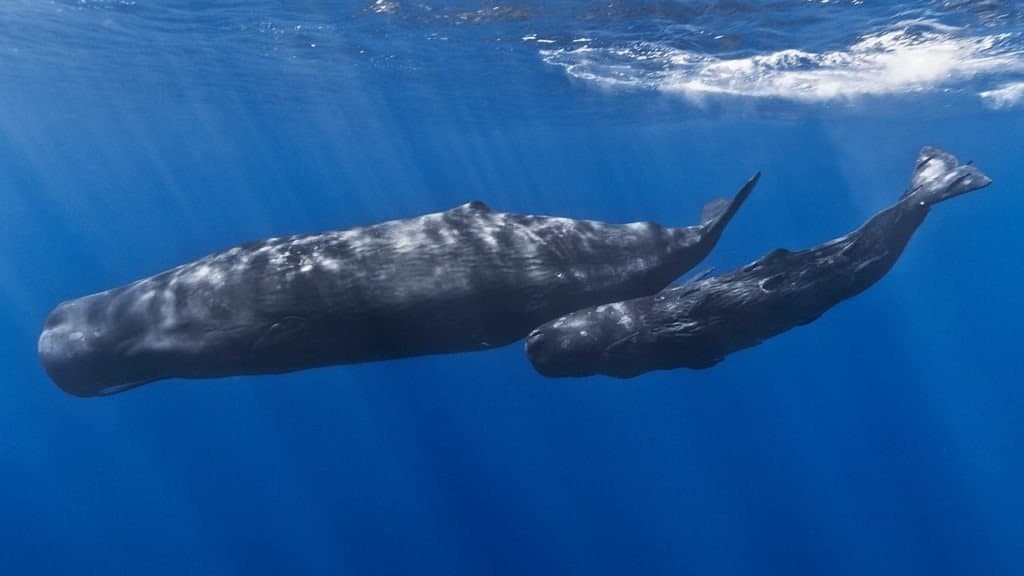
A mother sperm whale and her calf off the coast of Mauritius.
©Gabriel Barathieu / CC BY-SA 2.0 – License
According to research in Molecular Ecology, every living sperm whale is derived from a single grandmother 80,000 years ago. Researchers looked at 1,600 whales worldwide and found that all these whales carried the same mitochondrial DNA, genes passed down from mother to child and originating from the very same 80,000-year-old female progenitor.
3. They Were Once Sought For Spremaceti Fluid

Sperm whale and her calf swimming at the surface, Indian Ocean, Mauritius.
©wildestanimal/Shutterstock.com
The sperm whale has a spermaceti organ that can cover 40% of a whale’s length and hold 530 gallons of fluid. The spermaceti case is stiff and fibrous. Whalers hunted sperm whales for their spermaceti oil, used in cosmetics, soaps, and lamp oils. Ambergris, a hard, waxy, flammable compound generated in sperm whales’ intestinal tracts, is sought by perfumers as a fragrance fixative. Synthetic ambroxide has largely replaced it.
4. Sperm Whales Can Live For An Extended Period
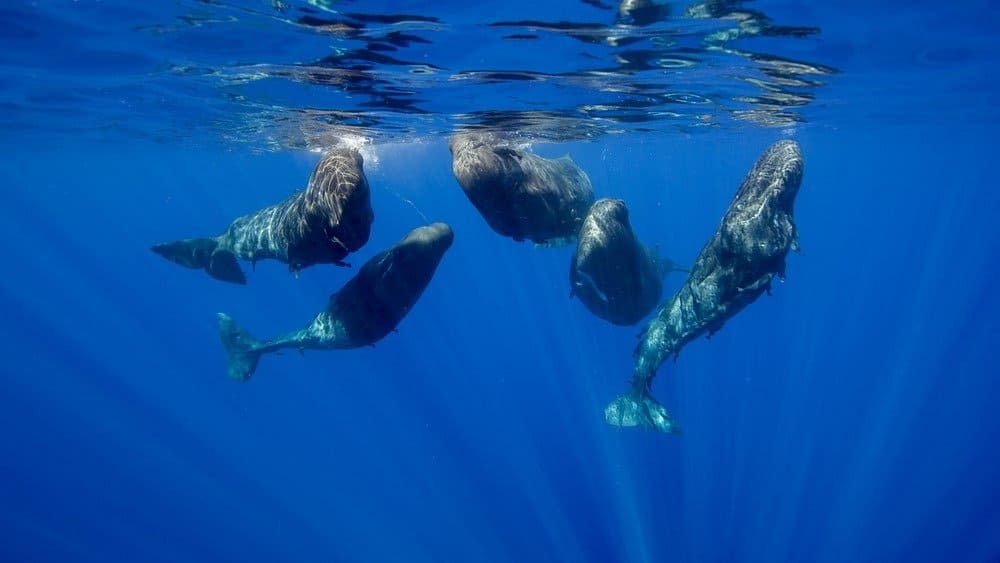
Sperm whales in a social gathering, Indian Ocean, Mauritius.
©wildestanimal/Shutterstock.com
They have a life expectancy of at least 70 years. Females begin ovulating around age nine. When it comes to pregnancy, the oldest recorded mother was 41 years old. Calves can nurse for up to 13 years, though this is an extremely rare occurrence. There are 19 to 42 months of lactation in a female’s reproductive cycle.
5. They Sleep Upright And Rarely
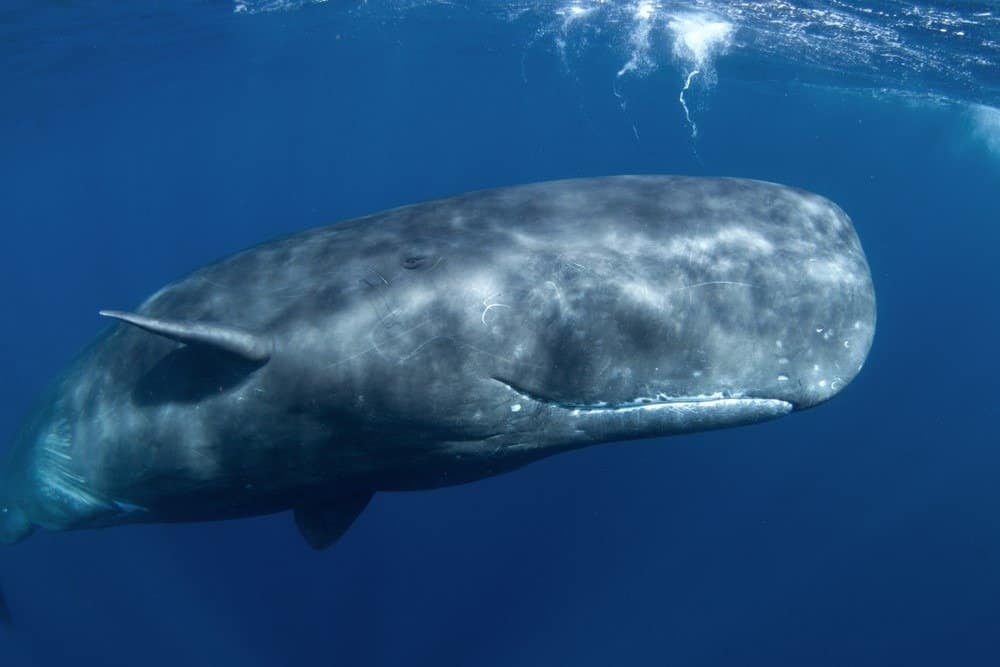
Sperm whale, Indian Ocean
©Martin Prochazkacz/Shutterstock.com
Sperm whales sleep briefly each night despite being huge predators. They’re the least sleep-dependent mammals because they only nap for 15 to 20 minutes at a time or 7% of the day. Vertically sleeping, their heads are at or below the surface. This sleeping pattern began being studied in 2008. During brief sleep, each whale floats for 15-20 minutes. They do not breathe during naps.
6. Sperm Whale Is The World’s Largest Toothed Predator

Sperm whale breaching off the coast of Pico Island, The Azores, Portugal.
©wildestanimal/Shutterstock.com
Male sperm whales attain physical maturity at 52 feet; however, some adults are as big as 68 feet! Males can weigh up to 80 tons, and on average, they are three times as large as their female counterparts. On average, females are approximately 40 feet long. Their heads can be up to one-third as long as the rest of their bodies.
7. Sperm Whales Use Echo-Location To Hunt
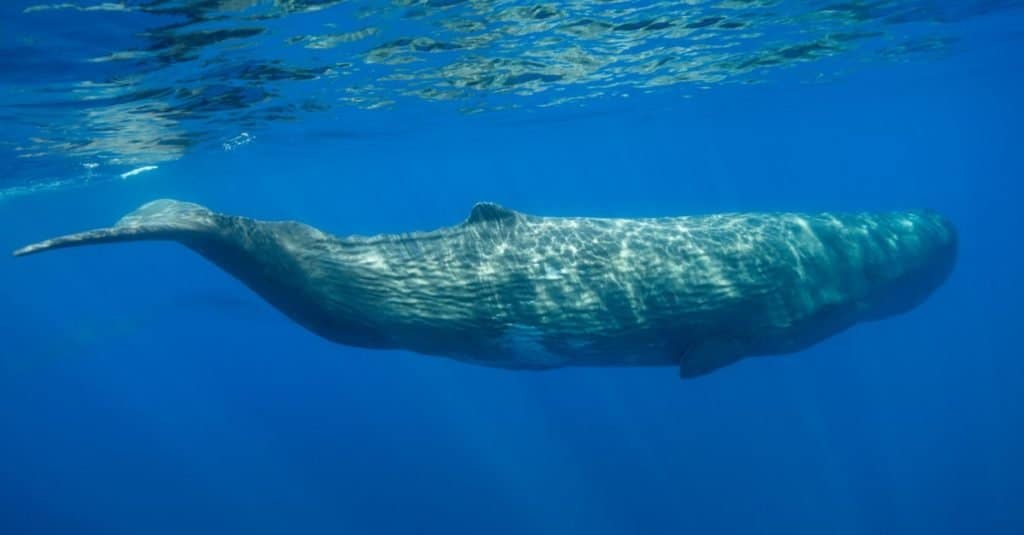
Sperm Whales are world-class divers. The mammals have been recorded descending to depths of over 3,280 feet and can go 90 minutes between breaths.
©wildestanimal/Shutterstock.com
The sperm whale is one of the loudest animals on Earth and uses echolocation that can reach 230 dB underwater. That is louder than a jet at takeoff! Some say they can kill or disable their target with sound alone. Sperm whales can produce 235 dB with a single click. Saturn V produces that much sound intensity at 3 ft.
Their clicks are called “codas.” Each whale has a “coda.” Scientists use this to tell whales apart. 650 to 3,300 ft underneath the ocean’s surface, sperm whales hunt via echolocation. They hunt prey in dark oceans by emitting high-pitched whistles and hearing the echoes bounce off things, a natural sonar!
8. Their Poop Is Used For Perfume

Sperm whale poop is used in perfumes
©wildestanimal/Shutterstock.com
Up to 80% of a sperm whale’s diet consists of giant and enormous squid. The whale’s digestive tract fills up with indigestible animal parts including beaks, and eyelids. Indigestible sections make whales puke or defecate. Parasitic worms, excrement, and protective wax rarely clump with whale digestive system components. The clump is defecated out or ruptures the whale’s colon, killing it.
After being discharged from the sperm whale, the cluster drifts for years. Microorganisms, enzymes, sunlight, and other ocean sources clean this clump. With time, the cluster becomes fragrant ambergris.
Here’s what’s incredible – this substance produced in sperm whale digestive tracks becomes extremely valuable! Ambergis has been highly valued by the perfume industry with its value being comparable to gold!
9. Sperm Whales Are Constantly Eating
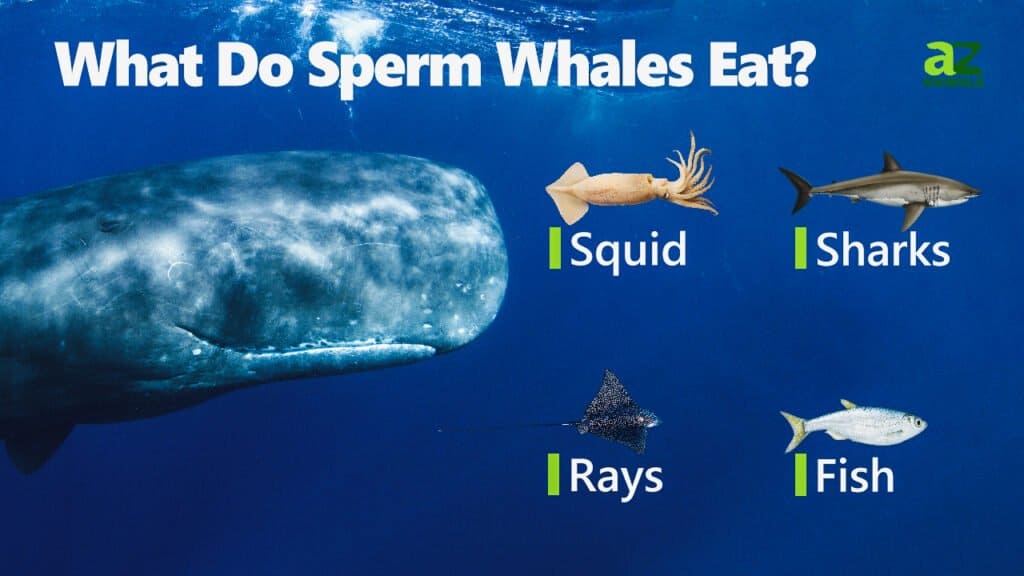
The sperm whale is constantly feeding. They are capable of consuming two tons of food in a single day, which is roughly equivalent to three percent of their whole body weight. To put this into perspective, its estimated sperm whales consume over 91 million tons of food every year. One estimate from 1977 even calculated that all sperm whales combined eat more than 100 million tons of just squid annually.
10. They Have The Largest Brains Of All Mammals

Sperm Whales have the largest brain of all mammals
The brain of the sperm whale, which weighs in at an average of 17 pounds and has a volume of approximately 8,000 cubic centimeters, is the largest known brain of any mammal, living or extinct.
The photo featured at the top of this post is © wildestanimal/Shutterstock.com
Thank you for reading! Have some feedback for us? Contact the AZ Animals editorial team.







